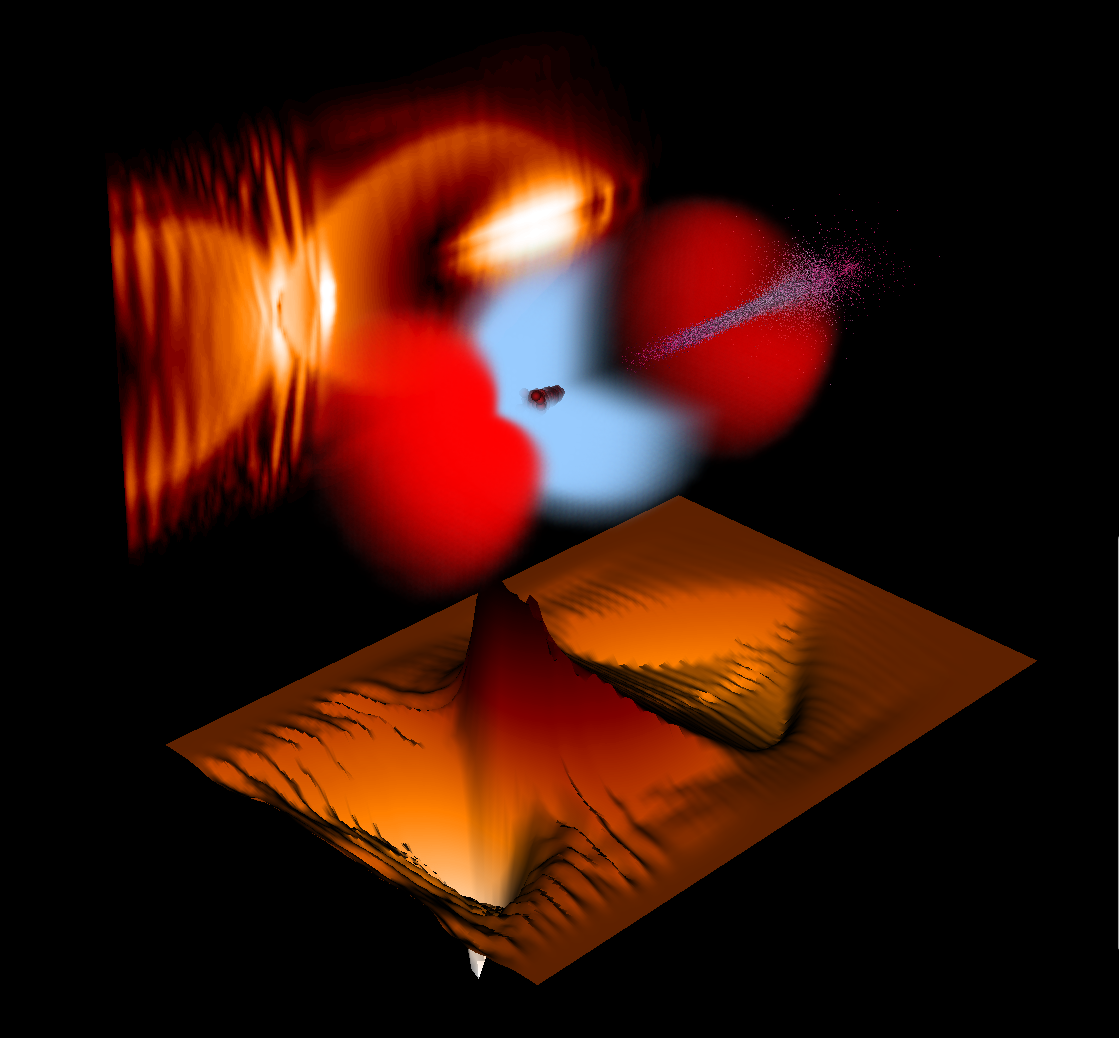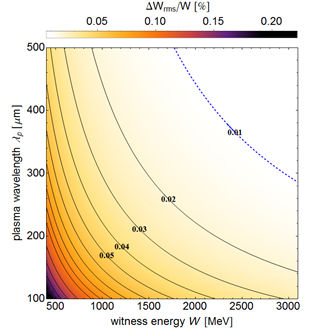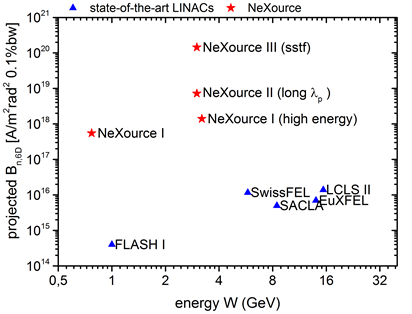![]() Boosting the electron beam brightness: NeXource
Boosting the electron beam brightness: NeXource
by Bernhard Hidding (University of Strathclyde)

Particle-in-cell-simulation with VSim: the driver beam propagates to the right and excites the plasma wave, which accelerates the witness bunch while being dechirped by an escort bunch population.(Courtesy: A.F. Habib)
Extremely high-quality electron beams are required to realize knowledge-generating machines in the hard x-ray regime or at the energy frontier. EuPRAXIA, the H2020 project exploring design options for a "European Plasma Research Accelerator with eXcellence In Applications", therefore aims to develop a compact plasma accelerator with superior beam quality. EuPRAXIA researchers at the University of Strathclyde and partners at the University of Hamburg/DESY and UCLA, supported by industry (RadiaBeam, RadiaSoft and Tech-X), have now developed a breakthrough technique which may allow to increase the brightness of electron beams by many orders of magnitude. The study has recently been published in Nature Communications [G. G. Manahan, A. F. Habib, et al., doi: 10.1038/ncomms15705].
While the huge accelerating electric fields of plasma accelerators allow to realize energy gains of many tens of GeV on few cm-scale lengths, the output electron beam quality is also of paramount importance for many key applications. One especially promising approach is the plasma photocathode a.k.a. “Trojan Horse” technique. The concept decouples injection from acceleration, and allows to generate tunable electron beams by controlled ionization injection with a synchronized laser pulse directly inside an electron beam driven plasma wave. This injection mechanism generates witness beams with orders of magnitude better normalized transverse emittance and 5d-brightness, because the laser pulse transfers very low residual transverse momentum to the electrons in statu nascendi. Such plasma photocathodes may have comparable impact as the development of conventional photocathodes, which was a key to realize hard x-ray FEL’s such as the LCLS or the European XFEL in Hamburg. Exploration of the Trojan Horse technique has therefore already been foreseen for large-scale plasma accelerator projects such as SLAC’s FACET-II, BNL’s ATF-II, DESY’s FLASHForward and for EuPRAXIA.
However, it is highly desirable to go even further, and to also tackle the “energy spread” problem. The ultrahigh electric fields in plasmas come at a price: they also produce ultrahigh electric field gradients. Therefore, the head of the accelerated electron beam gains energy at a lower rate than its tail. This leads to an electron beam energy “chirp” which gives rise to various significant problems e.g. during extraction, capture, transport and for applications, where it can be a showstopper e.g. for FEL.
The study in Nature Communications proposes to exploit tailored beam loading by so called “escort” electron bunches, again to be produced by the plasma photocathode technique, in order to flip the accelerating field and hence to obtain longitudinal phase space control over the witness bunch. Most importantly, the technique allows to remove the correlated energy chirp completely, leaving just the uncorrelated, residual energy spread. A discovered scaling law indicates that the relative energy spread of the dechirped bunch can reach sub-0.01%-levels at plasma wavelengths of ~500 µm and electron energies > 2 GeV. This energy spread is approximately two orders of magnitude improved compared to without dechirping.
This would boost the output of plasma accelerators e.g. in terms of 6d-brightness to levels beyond those of even the finest traditional accelerators. For example, the combination of low emittance, ultrahigh brightness and low energy spread may allow to beat the FEL Pellegrini criterion and the FEL Pierce parameter at the same time, and to harness ultrahigh gain.
Claudio Pellegrini (not involved in the study), one of the key figures in the history of the LCLS, said: "The path towards realizing the LCLS required a fundamental improvement of the electron beam quality obtainable from conventional accelerators. The approach Manahan et al. suggest now is very promising as regards obtaining a further step change in electron beam quality, this time to be enabled with plasma accelerators. This holds great prospects for the construction of future compact hard x-ray FEL's".
The combination of ultralow emittance and reduced energy spread may allow to realize next generation electron beam sources with ultrahigh 6D-brightness, an approach which the team calls the “NeXource” technique. Bernhard Hidding, who led the study and presented some of the results at IPAC’17, said that the novel concept could hardly come at a better time: “We have just seen first experimental signatures of the plasma photocathode in the ‘E210: Trojan Horse’ programme at SLAC FACET. Fascinatingly, it looks like the complex beam-plasma physics involved support each other to facilitate the mechanism. This is highly encouraging for future R&D along the NeXource approach.”
 |
 |
| Residual energy spread scaling law: reducing the plasma wavelength and increasing the electron energy can reduce the residual relative energy spread to sub-0.01% levels already at 2-3 GeV, an energy which is today routinely reached by plasma accelerators. (Courtesy: A.F. Habib and G.G. Manahan) |
The diagram indicates the projected 6d-brightness performance of the plasma-based NeXource approach in a couple of variations and at different energies when compared to state-of-the-art accelerators. (Courtesy: A.F. Habib and G.G. Manahan) |
Strathclyde’s Research & Knowledge Exchange Services office has patented the approach and is now working with well-known accelerator product SME RadiaBeam Technologies to further develop and commercialize the technology. The technology may enable future compact free-electron lasers with a shot-by-shot performance substantially better than today obtainable even from the best of today’s large machines, and may have transformative effect on this and other important areas of research in natural, life and material sciences. It may be a unique path forward for EuPRAXIA to realize the goal of compact hard x-ray free-electron-lasers, and to fertilize plasma-based linear collider and high energy physics efforts.
